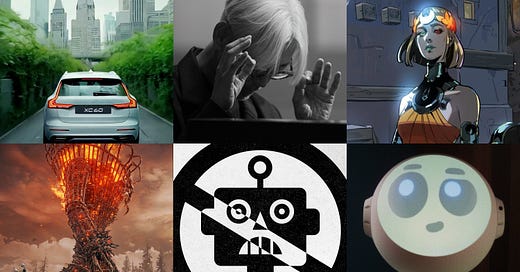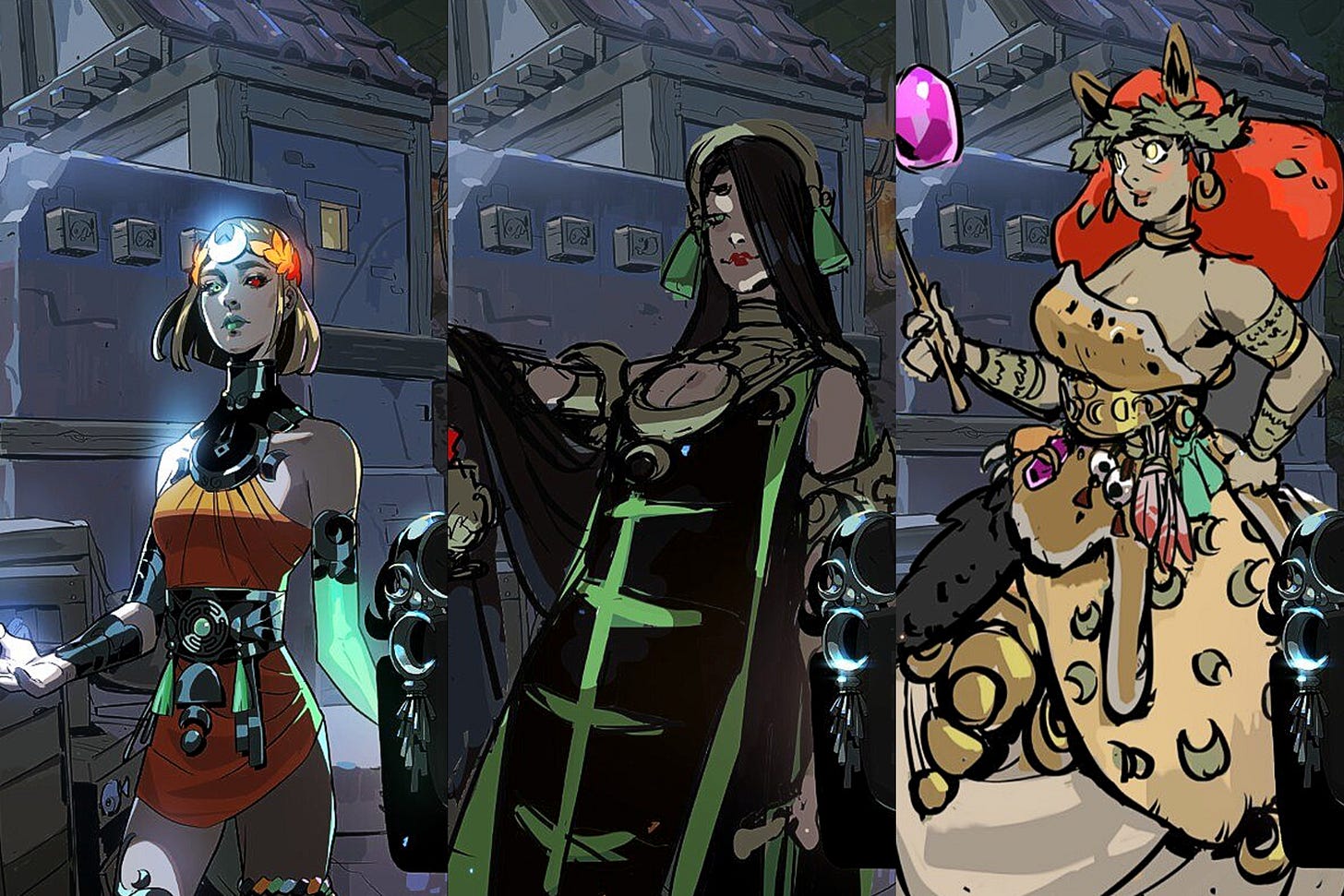Celebrating the human element of it all: The Week in Review
Some of the most creative work we've watched, read, and played this week.
Happy Friday! Somehow even when we say we're gonna blog, our wordcount tends to climb precipitously. But we digress.
There's been a lot more negative AI stories lately, and for very good reasons. Many of the biggest concerns around AI as a business have come to a head lately, with Goldman Sachs' report being one of the most damning (Ed Zitron, who has followed this thread for months, has a great writeup). Also this month, WIRED's Reece Rogers has published a piece looking at the massive energy demands for generative AI—which, if that makes you think about the wild story around energy demands at Bitcoin, you're not alone.
These are very important business stories, and we can't talk about the creative impact without them—the future of creativity is as much a business story as it is one about technology and culture. It's something we'll continue to tackle at MBH4H but we also want to be careful not to constantly write about how shitty AI is. There are far better writers equipped to make that their focus. Rather, we want to make sure our point of view is always in consideration of those making creative decisions first and foremost: the writers, the artists, the UX designers, etc. We do want to see people who use new technology in fascinating ways that push the boundaries where old technology couldn't. We don't want to be an AI blog, but rather, a creativity blog that acknowledges the existence of AI.
Being creative in the age of AI is as much about what avoids AI as what incorporates it. We've seen this trend before: Digital cameras created a love of shooting on film. A consequence of a music industry dominated by streaming is that vinyl sales are at a record high and Jony Ive designs $60,000 turntables. Fireworks are cool even when drone shows exist. Somehow, Game Boy cameras have returned as an aesthetic. We love tactile, physical play—some of which, yes, will use emergent technology in obvious and not-obvious ways to reach that goal.
We’re excited to be talking more about the modern creative world in those terms, and talking directly to many of those that are working and pushing boundaries (more to come on that later). But enough self-reflection, onto the must-reads of the week. —Ross and James
What We’ve Read
What is AI? (MIT Technology Review) Full disclosure: I haven't read all of this piece; I am still reading it—there's a lot here. But I find what I have read so far really interesting and I love the entire premise of this feature package: "What is AI?" is such an obvious question but I have yet to see it covered in such detail and with such clear, not-overtly-technical wording. It's also a question that anyone reading MBH4H will know we've also been thinking a lot about. I have changed my mind repeatedly about what I think AI is, and perhaps more importantly its value to me as a creative. My current position is that it is either a tool or a robot, and that the former is good while the latter is bad. But who knows what I will think once I get to the end of this long feature. —James
Why AI art will always kind of suck (Vox) Ross recently shared this piece with me from Vox by Rebecca Jennings that was published back in May and I am so glad he did. Rebecca articulates the "suckiness" of Generative AI art so beautifully throughout the piece that it's hard to pick a particular line to highlight. But one quote that hit me particularly hard is from Ryan Broderick, writer of Garbage Day, "My fear is that we're hurtling really quickly towards a world where rich people can read the words written by humans and people who can't afford it read words written by machines.”
I've previously written that I think creatives could draw lessons from the organic food industry and create business models where those of us who value human creativity pay more to support it. Ryan's quote made me realize that's a very privileged position on my part. We're already a nation that suffers from "food deserts" and "news deserts," and perhaps I shouldn't be so keen to advocate for a solution that could cause "creative" deserts, too. I don't want to live in a world where creative work made by humans is only available behind a paywall and everything free is made by AI and sucks. Rebecca's article and Ryan's quote especially gave me something to think about. —JamesErrol Morris on whether you should be afraid of generative AI in documentaries (Nieman Lab) "Ultimately, I think we should own up to the fact that we’re creating, that it’s not reality itself." Academy Award-winning filmmaker Errol Morris (The Thin Blue Line, The Fog of War) sits down with Nieman Labs' Andrew Deck to discuss the use of generative AI in documentaries. For context, Morris' use of reenactments in his own films was at one point considered controversial, especially as it has fooled many viewers into thinking those reenactments were “real” footage, but has now become a commonplace technique. The two discuss seemingly ethical uses of gen AI—like deepfakes to preserve anonymous sources—while also tackling its use generally both now and in the future. Morris doesn't come as pro-AI, in that he has no plans to use it himself, but rather anti-anti-AI. "I like to be in a position where I can examine and think about the relationship between film and reality, and not to obscure that distinction, but to enhance it and make people think about it. If OpenAI is a way to do that, well, fine."
AI has already become a technique that some filmmakers are using for reenactments, most notably Netflix’s recent documentary What Jennifer Did. Something else to keep an eye on here: This September, the Archival Producers Alliance plans to release guidelines on the use of generative AI in documentaries. Morris’ take on all this? “Everything is manipulated, everything is challenged, everything is endlessly falsified. I don’t know what the solution to that is,” and later in the interview, “Just because you follow a set of rules doesn’t mean that it’s any more real.” —Ross
Nintendo won't use generative AI in its first-party games (Tweaktown) I'm still thinking about these quotes even after they were already cited in James' “AI is a bad robot” essay from this week. I've been covering Nintendo for just shy of 20 years at this point, but even someone with passing knowledge probably knows it's a company that prides itself in zigging when everyone else is zagging. Some of those ways are obvious—every platform from Nintendo 64 onward has used some unique control scheme or layout, and its platform from Wii onward has abstained from using cutting-edge processors in lieu of form factor and competition price points—and in other ways more behind-the-scenes, like how employee retention rate is wildly high and that many of the original Mario and Zelda developers continue to work on the same franchises decades later.
Nintendo is a cautious company that exudes creativity within a more constrained bounding box. I think Nintendo is being very earnest here when they say AI is not something they're looking into—outside of any IP protection matters, of course, as Nintendo is very on top of things when it comes to litigation. Rather, I think Nintendo is happy to let others wade into AI first, and then maybe somewhere down the line, find small ways to incorporate narrowly-focused aspects of AI where it can conform around human-directed creative decisions. AI visual upscaling? Probably at some point. An AI Pokemon generator? Almost certainly not. —RossFake Volvo ad made with AI stirs marketers (AdAge) The optimists in us are always on the lookout for clever, creative uses of generative AI, particularly on projects where it's hard to fathom being made any other way—when AI feels like a necessary tool rather than a tacked-on gimmick. This mock Volvo ad from artist and colorist Laszlo Gaal fits that bill. It's a 45-second video takes inspiration from the Volvo For Life Fund and follows a Volvo facsimile as it drives through the city, creating lush greenery in increasingly surreal ways as it goes. (To be clear, this was not made with Volvo's involvement; rather this can be more considered a "brand fan" video.) The tech angle here is that the video was created entirely using the generative tool Runway, and reportedly all done within 24 hours. Creatively, though, it’s got staying power well beyond a day. It’s an interesting, very cohesive concept that tells a story and uses a spectacle that would be hard to recreate in any other way, at least at a reasonable budget and timeframe.
AdAge's Asa Hiken caught up with Gaal, who shared some background on the video's creation and offered some tips on how to best use AI tools. All of which are pretty universally applicable to be honest—to oversimplify things, work within a technology's constraints, be a smart editor throughout the entire creative process (“kill your darlings”), and don't let AI try to mock up any brand products. Lessons that, oh I don't know, maybe a certain toy / nostalgia bait company should probably take to heart. —Ross
What We’ve Watched
Ryuichi Sakamoto Opus, available to buy or rent on Apple TV+, is about as far away from AI as it is possible to get. Filmed only months before Sakamoto's death from cancer in March 2023, this documentary, directed by his son Neo Sora, is a minimalist masterpiece—both in terms of the filmmaking and music.
Shot entirely in black and white, Bill Kirstein's cinematography is as exquisite as it is intimate. It follows a theme of night to day and back to night again: a stark chiaroscuro falls across the studio, piano, and Sakamoto himself, dressed entirely in black, while he plays 20 of his most famous pieces of music, occasionally halting mid-piece to replay certain phrases or chords.
The sound design by recording engineer ZAK captures not only the notes of the piano but also the mechanical sounds of the keys and pedals as Sakamoto plays, the creaking of the piano stool, and even the rustling of his clothes and his breathing. As Sora says in an interview with Variety, "The other thing was that Bill [Kirstein] and I were really careful about making sure that until the performance ends, everyone's filming, so I was making sure to only call "cut" once the sound is completely gone." As a long-time fan of Sakamoto and his music, I have watched this film two or three times and listened to it many more. It is such a powerful and poignant tribute.
By way of a complete contrast, I'm only two episodes into Sunny but already hooked. The show, also airing on Apple TV+( which is proving itself to be the HBO of our times), stars Rashida Jones as a grief-stricken woman living in near-future Kyoto trying to come to terms with the death of her husband and son with the help of a wise-cracking Homebot called Sunny. It's like a cross between an Agatha Christie whodunit and Scooby Doo, but set in the future. It's wonderful. —JamesAt Ross’s recommendation, I recently watched Godzilla Minus One. This film is everything it’s cracked up to be and perfectly illustrates how it is possible to make a brilliant, entertaining film that connects with audiences and costs significantly less than $200 million (it had a budget around $15 million). If you haven’t seen this film, you definitely should, even if you have little interest in Godzilla movies: Godzilla Minus One isn’t about a city-sized monster; it’s about human-sized people. Godzilla Minus One is available to stream on Netflix, or buy on AppleTV. The Collector’s Edition has just been released on Blu-Ray. —James
What We’ve Played
A big trend in gaming for the past several years is early access releases—when a game becomes available to purchase and play before it is finished, where player feedback can be used to test features en masse ahead of the final "1.0" release, where a broader audience starts taking interest and most media finally give it a "proper," Metascore-influencing review. It's a model that has mixed success at times, such as where a game is very much lacking in enough prerelease content to justify the upfront cost, and a model often used not for creative reasons but financial need (ie. "we need the early access so that we can fund finishing the game").
Supergiant Games' 2020 hit Hades is a case study in how to do an early access release right, and Hades 2, recently released in early access, is already shaping up to do it even better. The game launched with a "box weight" (generally speaking, the amount of Stuff To Do) that arguably exceeded the original, which means there is already so much game to play—I've personally clocked in just over 60 hours at this point. It's a roguelite, which means each run of the game takes from a pool of familiar elements (items, enemies, level layouts) and randomizes them within a set of rules, so that it always feels different and challenging, while the macro-level goals and progression milestones mean there's a feeling of reward even if you fail a run (and you will fail often).
But while for most people I would suggest waiting for the final release, those with a willingness or even an eagerness to see a work-in-progress game should consider picking it up sooner rather than later. It's utterly fascinating to see what is there, what isn't there yet (the devs have been very communicative over what's to come, albeit without spoiling any story beats), and most excitingly, what the devs chose to include as a placeholder. Some of it is very comical and unique to early access, like increasingly silly and meta voiceover lines the more times you reach the end of the available content, and also some of it is just an interest but small peek behind the curtain. A handful of characters have placeholder artwork that feels very much like an early sketch compared with the more refined, more visually striking portraits elsewhere in the game. It's not something you would ever get to see in a final game, and to be sure, it probably isn't long for this world even in prereleases. But as a captured moment in time, and especially when it's rare to have any view behind the curtain of development, it's a small but wonderful little detail. —Ross
I’ve done it! I have beaten the unholy challenging final boss in the Land of Shadows and with it, the Elden Ring Shadow of the Erdtree DLC. Yes, beating this stupidly hard boss took me many attempts and yes, I had to summon another player to help me get through it but I’m still taking the win. Of course, I am not finished in the Land of Shadow, I still have more dungeons and old forges to explore, and I have yet to take down a Furnace Golem—who are proving to be annoying in the extreme. But they’re for another day. In the meantime, I am going to enjoy some more sightseeing on Torrent and whacking some random soldiers with my new weapon: a massive dried sunflower that can be wielded as a holy hammer. I love it when FromSoft get really fucking weird. —James
Not “Played,” per se, but within the realm of gaming, 8BitDo is celebrating its 11th anniversary this week. I grew up in an era where third-party video game accessories existed solely as "cheap" alternatives to the official controllers or those that have some gimmicky features like autofire (ie. "Hold this button to spam X very quickly without hurting your thumb"). These days, companies like 8BitDo have made third-party controllers and accessories not only good but coveted. Every controller they have made—some more original, some very much an homage to retro titles—are among the best you can use in gaming, both in form and in function. To celebrate its 11th birthday, the company has released limited edition gold and silver, Super Nintendo-inspired gamepads, and for the first time, I don't want to play with these. I want to frame them. —Ross
What else we’ve loved: LEGO!
As anyone who has ever had a conference call with me already knows, I love LEGO (always singular, always capital letters). The shelves in my office feature lots of LEGO Star Wars: Luke's Landspeeder, BB8 and the Snowspeeder. I also have the X-Wing kit but haven't built it yet; I've been too distracted by Elden Ring. But before I build the X-Wing, I am going to build the LEGO Plum Cherry Blossom I have on order. I need some flora and fauna in my life, even if it's made of plastic. After that, maybe I'll succumb and buy the new C-3PO.
And while we're talking about LEGO, check out the new LEGO by Interbrand & OLA brand guidelines and also read this hilarious non-sequitur… $200,000 in stolen LEGO?? I had no idea there was such a robust industry in "fallen off the back of a lorry" LEGO sets. —James









